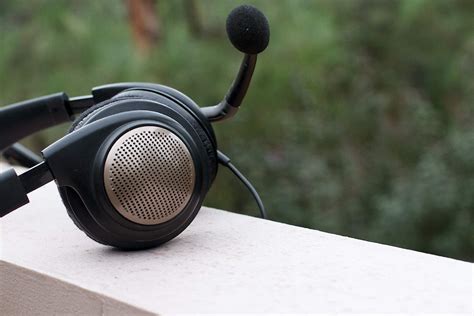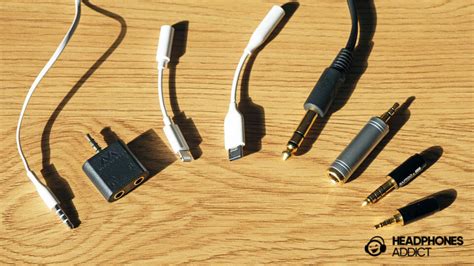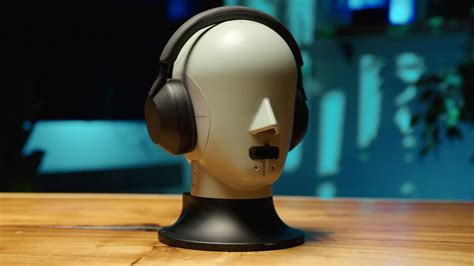In today's fast-paced world, where technology plays an indispensable role in our daily lives, headphones have become a crucial accessory for many individuals. Whether you are a music enthusiast, a podcast lover, or an avid gamer, a pair of headphones can transport you into a world of immersive audio experiences. However, just like any other piece of technology, these devices may encounter glitches and malfunctions, leaving you frustrated and searching for solutions.
Imagine this scenario: you are eagerly waiting to listen to your favorite album or engage in an intense gaming session, but suddenly, your beloved headphones start acting up. The sound becomes distorted, or worse, completely disappears. Panic sets in, and you are left wondering what could be the cause of this unexpected malfunction. Fear not, for in this article, we will provide you with a comprehensive guide on troubleshooting common issues that can arise with your wired headphones.
The world of headphones is vast and diverse, with numerous brands and models available in the market. While this abundance allows us to find the perfect fit for our audio needs, it also means that troubleshooting headphone problems requires a tailored approach. The first step in resolving any headphone-related issue is to understand the underlying causes. From loose connections and faulty cables to software conflicts and device compatibility, there are several factors that might contribute to the malfunctioning of your headphones.
Troubleshooting Tips for Non-Functional Wired Headphones

In this section, we will explore various troubleshooting techniques to address issues with your wired headphones that are not functioning properly. When encountering problems with your headphones, it can be frustrating and inconvenient, but with the right tips and tricks, you can often resolve the issues without much hassle.
- Check the connection: Ensure that the headphone jack is securely plugged into the device you are using. Sometimes, a loose connection can cause audio problems or result in no sound at all. Try gently reinserting the headphone plug to ensure a proper fit.
- Inspect the cable: Carefully examine the headphone cable for any signs of damage such as cuts, frays, or bends. Damaged cables can disrupt the audio signal and cause issues with the headphones. If you spot any damage, it may be necessary to replace the cable.
- Test with a different device: Connect your wired headphones to another device to determine if the problem lies with the headphones or the device you were initially using. If the headphones work fine with a different device, it suggests that there might be an issue with the original device's audio output.
- Clean the headphone jack: Over time, dust and debris can accumulate in the headphone jack, leading to poor audio quality or no sound. Gently clean the jack using a cotton swab or a small brush to remove any dirt or lint. Be cautious not to apply excessive force, as this can damage the jack or push debris further inside.
- Update audio drivers: If you are using your headphones with a computer, outdated or incompatible audio drivers can cause disruptions. Visit the manufacturer's website and download the latest drivers for your specific audio device and operating system. Installing the updated drivers may help resolve any compatibility issues.
- Try a different pair of headphones: If none of the above steps solve the problem, it may be worth testing a different set of headphones. This will help determine if the issue lies with the headphones themselves or with the audio output of the device being used.
By following these troubleshooting tips, you can increase the chances of resolving issues with non-functional wired headphones. Remember to remain patient and cautious while performing any repairs or cleaning tasks to avoid causing further damage. If the problem persists, it may be necessary to consult a professional or consider getting a new pair of headphones.
Check the Connection
In this section, we will explore the various steps you can take to examine the link between your headphones and the connected device. By focusing on the connection, we can troubleshoot and resolve any issues that may be interfering with the proper functionality of your headphones.
Clean the Audio Jack and Headphone Plug

Ensure optimal functionality of your wired listening devices by maintaining a clean audio jack and headphone plug. Over time, dirt, debris, and dust can accumulate in these areas, leading to connectivity issues and compromised audio quality. To address this, it's crucial to regularly clean the audio jack and headphone plug, thus promoting a seamless and enjoyable auditory experience.
Step 1: Preparation and Safety Measures
Before cleaning, make sure the headphones are disconnected from any devices and turned off. This prevents accidental damage or electric shock. Additionally, gather the necessary cleaning materials, such as a lint-free cloth, cotton swabs, isopropyl alcohol, and a toothpick.
Step 2: Cleaning the Audio Jack
Take the toothpick and gently insert it into the audio jack, being cautious not to apply excessive force. Move the toothpick around to dislodge any dirt or debris trapped inside. Once the loosened particles are dislodged, carefully remove them from the audio jack using the lint-free cloth or cotton swabs. Ensure that no residue is left behind.
Step 3: Cleaning the Headphone Plug
Similarly, use the toothpick to remove any visible dirt or debris from the headphone plug. Be gentle to avoid bending or damaging the plug. Afterward, dampen the lint-free cloth with isopropyl alcohol and gently wipe the headphone plug, eliminating any remaining residue and ensuring a clean connection.
Step 4: Drying and Reconnecting
Allow both the audio jack and headphone plug to air dry completely before reconnecting them. This helps prevent moisture from causing further issues. Once dry, firmly plug the headphones back into your device, ensuring a secure and snug connection.
Step 5: Regular Maintenance
To maintain optimal performance, it's recommended to clean the audio jack and headphone plug periodically, especially if you frequently use your wired headphones. This preventive measure can help prevent future connectivity issues and preserve the audio quality of your listening experience.
Note: It's important to exercise caution and patience when cleaning the audio jack and headphone plug. If you encounter any difficulties or if the issue persists, it's advisable to consult a professional or contact the manufacturer for assistance.
Update Audio Drivers on Your Device
Ensure optimal performance of your audio devices by keeping your device's audio drivers up to date. By updating the audio drivers on your device, you can enhance the functionality and compatibility of your wired headphones, improving your overall listening experience.
Step 1: Identify the type of device you are using. |
Step 2: Visit the manufacturer's website for your device. |
Step 3: Navigate to the drivers or support section of the website. |
Step 4: Locate the latest audio driver for your device model and download it. |
Step 5: Once downloaded, open the driver file and follow the on-screen instructions to install the updated driver. |
Step 6: Restart your device to apply the changes. |
Updating your audio drivers can resolve various issues with your wired headphones, such as distorted sound, one-sided audio, or no sound at all. It is recommended to periodically check for driver updates to ensure you are getting the best audio performance from your headphones. Remember to consult the device manufacturer's instructions for specific driver update procedures to ensure a smooth process.
Test the Headphones on a Different Device

Try connecting your headphones to another device to determine if the problem lies with the headphones themselves or with the original device you were using. By doing this, you can eliminate potential issues related to the specific device and focus on troubleshooting the headphones.
Why Testing on a Different Device Is Important
If your headphones are not functioning properly, it is crucial to test them on another device to gather more information about the issue. This step helps in identifying whether the problem lies with the headphones or with the device they were originally connected to. By testing on a different device, you can isolate the issue and troubleshoot accordingly.
Steps to Test on a Different Device
First, select another device that supports headphone connectivity, such as a smartphone, tablet, or computer. Make sure it is functioning correctly and has a functioning headphone jack or compatible port. Next, connect your headphones to the secondary device using the appropriate connectors or adapters. Test different audio sources, such as music, videos, or phone calls, to check for any irregularities in sound quality, volume, or functionality.
Interpreting the Results
If the headphones perform normally on the second device, it indicates that the issue lies with the original device. In this case, you might need to troubleshoot software settings, update drivers, or seek professional assistance if necessary. However, if the headphones still exhibit problems on the different device, it suggests that the issue lies with the headphones themselves or with the connector cables. Further troubleshooting or professional repair may be required to fix the problem.
Remember, testing your headphones on a different device helps in pinpointing the source of the problem, enabling you to take the necessary steps to resolve the issue effectively.
Consider Repair or Replacement Options
When faced with issues regarding the functionality of your connected headphones, it may be necessary to explore potential solutions. This section will offer insight into the various options for repair or replacement that can be considered to address the problem at hand.
- 1. Troubleshooting: Before jumping to conclusions, it is advisable to attempt basic troubleshooting steps. This may include checking the audio settings on your device, testing the headphones with a different device, or even examining the cable connections for any loose or damaged parts.
- 2. Cable Replacement: If the issue lies specifically with the cable of your headphones, replacing it may be a viable option. This can involve purchasing a new cable either directly from the headphone manufacturer or from a third-party provider. Ensure compatibility and quality before making a final decision.
- 3. Earpad Replacement: Over time, the earpads on headphones can wear out or become uncomfortable. If this is the case, consider replacing them with new ones. Many headphone manufacturers offer replacement earpads that can easily be attached, restoring both comfort and functionality.
- 4. Driver Repair: If the audio quality from the headphones is compromised or distorted, the issue may lie with the headphone drivers themselves. In such cases, professional repair or driver replacement services may be required. It is recommended to seek assistance from authorized service centers or technicians skilled in handling audio equipment.
- 5. Warranty Coverage: If your headphones are under warranty, it is worth checking the terms and conditions for coverage of repairs or replacement. Contact the manufacturer or authorized service centers to determine the potential options available and any associated costs.
- 6. Upgrading and Replacement: In some instances, it may be more practical to upgrade to a new pair of headphones rather than investing time and money into repairs. Consider evaluating the lifespan, features, and overall condition of your current headphones before making a decision. Researching and exploring different models and brands can lead to finding a suitable replacement that fits your needs and preferences.
By considering the various repair or replacement options available, you can make an informed decision on how to address the issues with your wired headphones. Remember to weigh the costs, benefits, and feasibility of each option to find the most suitable solution.
FAQ
My wired headphones suddenly stopped working, what should I do?
If your wired headphones have stopped working, there are a few troubleshooting steps you can try to fix the issue. First, check if the problem lies with the headphones or the device you are connecting them to. Test the headphones on another device to see if they work. If they do, then the issue is with your original device. If they don't work on another device either, try cleaning the headphone jack and make sure it is not blocked with debris. If that doesn't fix the problem, it might be a hardware issue and it is recommended to contact the manufacturer or get them repaired.
Why is there no sound coming from my wired headphones?
If you are not getting any sound from your wired headphones, there could be several reasons for it. First, check if the headphones are correctly plugged into the device. Make sure they are fully inserted into the headphone jack. If that's not the issue, try using a different pair of headphones to see if the problem lies with the headphones or the device. If the other headphones work, then the problem is with your original headphones. It could be a wiring issue or a faulty connection. In such cases, it is best to contact the manufacturer or get them repaired.
My wired headphones are working, but the sound quality is very poor. What can I do?
If your wired headphones have poor sound quality, there are a few things you can try to improve it. First, check if the audio settings on the device are properly configured. Adjust the equalizer settings or try different audio profiles to see if it makes a difference. If that doesn't help, try cleaning the headphone jack and contacts on the headphones using a soft cloth. Sometimes, dirt or debris can affect sound quality. If the issue persists, it might be a sign of wear and tear, and getting a new pair of headphones would be recommended.
My wired headphones have a loose connection, causing intermittent sound. How can I fix this?
If your wired headphones have a loose connection, causing intermittent sound, there are a few steps you can take to try and fix it. First, check if the issue is with the headphone jack. Try gently inserting the headphones in different directions to see if you get a better connection. If that doesn't work, you can try using a different device to see if the problem lies with the original device. If the headphones still have a loose connection, it might be a wiring issue. In such cases, it is best to contact the manufacturer or get them repaired by a professional.
What do I do if my wired headphones are not recognized by my device?
If your wired headphones are not being recognized by your device, there are a few things you can try. First, check if the headphone jack on your device is working properly. Try using a different pair of headphones to see if they are recognized. If other headphones work, then the issue might be with your original headphones. In that case, check if the headphones are properly inserted into the jack and try cleaning the contacts on the headphones. If none of these steps work, it could be a compatibility issue or a hardware problem. It is best to consult the device's manual or contact the manufacturer for further assistance.




